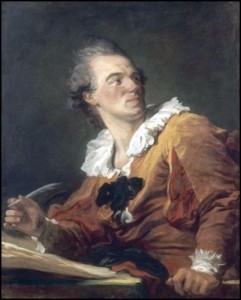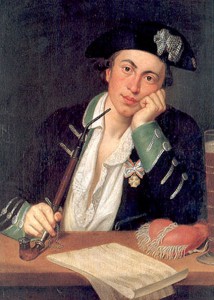
Although the Chicago Symphony Orchestra has performed music by more than a thousand composers over its 123 seasons, it has never before played a work by Henri-Joseph Rigel, whose C Minor Symphony opens this week’s concerts on May 8-10. (Joseph Martin Kraus, whose E Minor Symphony follows after intermission, is another newcomer to the CSO’s repertoire.) Rigel is virtually unknown to audiences today, but he was one of the most highly regarded composers in Paris, a great music capital, in the last years of the 19th century.
 Born in Germany, Henri-Joseph Rigel (at left) studied with the well-known Neapolitan composer Niccolò Jommelli in Stuttgart, and then, after being sent to France “for the education of a young person,” as his first biographer put it, he settled in Paris in 1767, at the age of 26. That same year, his name appeared for the first time in the catalog of the prestigious Leipzig music publisher, Breitkopf, as the composer of seven symphonies. (Six keyboard sonatas, published in Paris that year, are dedicated to Mlle Dupin de Francueil, who would later become the aunt of novelist George Sand.)
Born in Germany, Henri-Joseph Rigel (at left) studied with the well-known Neapolitan composer Niccolò Jommelli in Stuttgart, and then, after being sent to France “for the education of a young person,” as his first biographer put it, he settled in Paris in 1767, at the age of 26. That same year, his name appeared for the first time in the catalog of the prestigious Leipzig music publisher, Breitkopf, as the composer of seven symphonies. (Six keyboard sonatas, published in Paris that year, are dedicated to Mlle Dupin de Francueil, who would later become the aunt of novelist George Sand.)
Although he composed 14 works for the stage, the music is mostly lost. Rigel’s chief success was with his instrumental music, which includes more than 20 works for orchestra. In all, 14 symphonies for orchestra were printed in Paris during Rigel’s lifetime. On Feb. 2, 1774, one of Rigel’s symphonies was performed on a program at the Concert Spirituel, a prestigious series held in the Tuileries Palace, and that same year, Rigel (with his wife Marie serving as engraver) brought out his first collection of six symphonies, op. 12. The C Minor Symphony performed this week is the fourth work in that set.
In Paris at the time, the rage was for big orchestras, greatly expanded in size and quality over the 18th century standard, and Rigel accordingly wrote large-scale effects and virtuosic parts, knowing that the Parisian players were among the best in Europe. In 1780, Jean-Benjamin de Laborde, Rigel’s biographer, wrote: “All his effects are clear; his greatest symphonic pieces consistently have a natural melody.” The C Minor Symphony has the typical three movements of the day: a dramatic rapid opening; a slow, aria-like centerpiece, and a spirited finale. The music is fully responsive to all the latest developments in European music. “He dislikes factions,” Laborde wrote, “and he does not devote himself exclusively to any genre; but recognizing the benefits of each style (French, Italian, German) he is one of the foreigners amongst us who do the greatest honor to music in France.”
* * *
Of all the forgotten names in the history of music, Joseph Martin Kraus (below right) is one of the greatest mysteries. When he made his four-year grand tour of European music centers in the 1780s, traveling through Germany, Austria, Italy, France, and England, he met Joseph Haydn in Vienna. Haydn later said he thought Kraus was a genius on the level of Gluck, Salieri and even Mozart. “That man has a great style,” he reportedly commented, “the like of which I have found in no one else.”
 In Vienna, Kraus joined the same Masonic lodge as Mozart. Wherever he went, he moved in the right circles, from an artistic point of view.
In Vienna, Kraus joined the same Masonic lodge as Mozart. Wherever he went, he moved in the right circles, from an artistic point of view.
After a substantial German education, which included studies in philosophy and law at Mainz and Göttingen, Kraus went to Stockholm, where he was bent on a career in music at the court of Gustav III. It was Gustav who ultimately sent him on the grand tour to absorb the musical fashions in continental Europe. In his travels, Kraus met not only Haydn, but Gluck and Salieri as well. (He arrived in England in time to participate in the Handel centenary celebrations of 1785.) After he returned to Stockholm, he became Gustav’s favored musician, and in 1792, attended the masked ball at which his patron was assassinated — the incident that would later inspire Verdi’s Un ballo in maschera. Kraus himself died from tuberculosis later that same year.
We do not know how many symphonies Kraus wrote; the 14 that survive span his entire career, from his earliest student days in Mannheim from his earliest student days in Mannheim to a funeral symphony for Gustav III, written just a few months before his own death. The authorship of the E Minor Symphony used to be up for debate. One source, a manuscript housed in Regensburg, is attributed to Kraus; another, printed by the Paris publisher Boyer, credits Giuseppe Cambini as the composer. (Kraus visited both Regensburg and Paris on his European tour.)
Recent scholarship has placed the work firmly in Kraus’ catalog, but, even so, the exact date of its composition is a matter of conjecture. Apparently Boyer decided that Kraus was not well enough known to sell in Paris and used Cambini’s name, which evidently had market appeal at the time, instead. Kraus’ E Minor Symphony, in the traditional three-movement design, demonstrates the fruits of a happy union of German training, cosmopolitan outlook and genuine originality.
Phillip Huscher is the program annotator for the Chicago Symphony Orchestra.